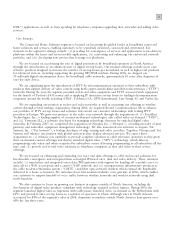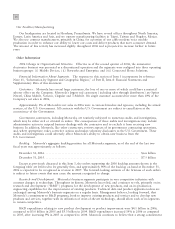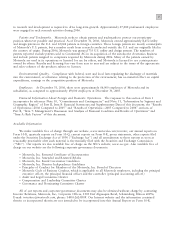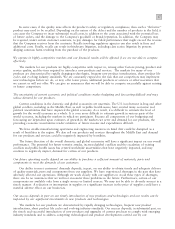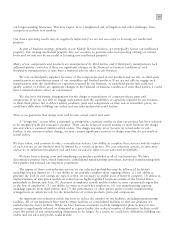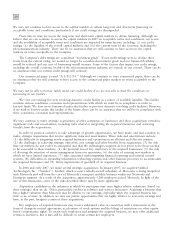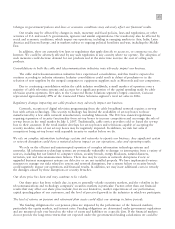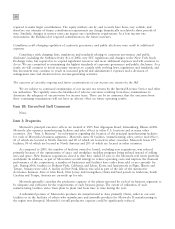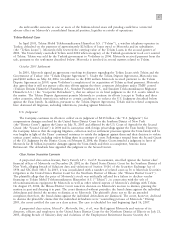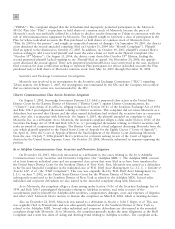Motorola 2006 Annual Report Download - page 26
Download and view the complete annual report
Please find page 26 of the 2006 Motorola annual report below. You can navigate through the pages in the report by either clicking on the pages listed below, or by using the keyword search tool below to find specific information within the annual report.
18
competitors. The research and development of new, technologically-advanced products is a complex and uncertain
process requiring high levels of innovation, as well as the accurate anticipation of technological and market trends.
We may focus our resources on technologies that do not become widely accepted and are not commercially viable.
In addition, products may contain defects or errors that are detected only after deployment. If our products are not
competitive or do not work properly, our business will suffer.
Our results are subject to risks related to our significant investment in developing and introducing new
products, such as: seamless mobility products; advanced wireless handsets; WiMAX and other advanced
technologies for wireless broadband networks; products for transmission of telephony and high-speed data over
hybrid fiber coaxial cable systems; integrated digital radios; and integrated public safety systems. These risks
include: (i) difficulties and delays in the development, production, testing and marketing of products; (ii) customer
acceptance of products; (iii) the development of, approval and compliance with industry standards; (iv) the
significant amount of resources we must devote to the development of new technology; and (v) the ability to
differentiate our products and compete with other companies in the same markets.
Our success, in part, will be affected by the ability of our wireless businesses to successfully compete in the
ever-evolving markets in which we participate. We face intense competition in these markets from both established
companies and new entrants. Product life cycles can be short and new products are expensive to develop and bring
to market.
Our success is dependent, in part, upon our ability to form successful strategic alliances. If these arrangements do
not develop as expected, our business may be adversely impacted.
We currently partner with industry leaders to meet customer product and service requirements and to develop
innovative advances in design and technology. Some of our partnerships allow us to supplement internal
manufacturing capacity and share the cost of developing next-generation technologies. Other partnerships allow us
to offer more services and features to our customers. If such arrangements do not develop as expected, our
business could be adversely impacted.
We rely on third-party distributors, representatives and retailers to sell certain of our products.
In addition to our own distribution force, we offer our products through a variety of third-party distributors,
representatives and retailers. Certain of our distributors or representatives may market products that compete with
the Company's products. The loss, termination or failure of one or more of our distributors or representatives to
effectively promote our products, or changes in the financial or business condition of these distributors,
representatives or retailers, could affect the Company's ability to bring its products to market.
Our business will be harmed if we are found to have infringed intellectual property rights of third parties, or if our
intellectual property protection is inadequate to protect our proprietary rights.
Because our products are comprised of complex technology, we are involved in litigation regarding patent and
other intellectual property rights. Third parties have asserted, and in the future may assert, claims against us alleging
that we have infringed their intellectual property rights. If we do not succeed in any such litigation, we could be
required to expend significant resources to pay damages, develop non-infringing intellectual property or to obtain
licenses to the intellectual property that is the subject of such litigation. However, we cannot be certain that any
such licenses, if available at all, will be available to us on commercially reasonable terms. Also, defending these
claims may be expensive and divert the time and efforts of our management and employees.
Our patent and other intellectual property rights are important competitive tools and may generate income
under license agreements. We regard our intellectual property rights as proprietary and attempt to protect them
with patents, copyrights, trademarks, trade secret laws, confidentiality agreements and other methods. We also
generally restrict access to and distribution of our proprietary information. Despite these precautions, it may be
possible for a third party to obtain and use our proprietary information or develop similar technology
independently. In addition, effective patent, copyright, trademark and trade secret protection may be unavailable or
limited in certain foreign countries. Unauthorized use of our intellectual property rights by third parties and the cost
of any litigation necessary to enforce our intellectual property rights could have an adverse impact on our business.
As we expand our business, including through acquisitions, and compete with new competitors in new markets,
the breadth and strength of our intellectual property portfolio in those new areas may not be as developed as in





